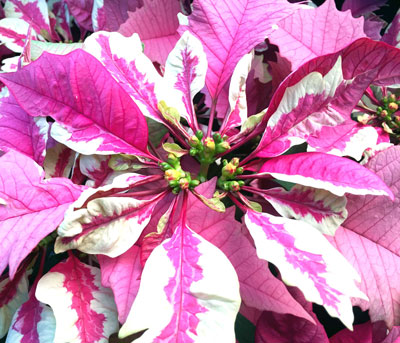Poinsettias from a Different Perspective
I promised you poinsettias from a different perspective. See how many of these facts you already knew.
• In a frost-free location, poinsettias are very large shrubs (to 8 or 10 ft. tall and wide).
• All poinsettia flowers are the very same color. Yellow. They’re the little taco-shaped things in the centers of the showy floral bracts.

• “Floral bracts” are modified leaves that you may have been calling “petals.” Look closely at your poinsettia and you’ll see how the first colorful “petals” actually are more in the shape of leaves. Because they are leaves. As the plant matures its bracts they become more elongated and less pointed/lobed.
• Poinsettias are photoperiodic. That means that they measure the length of the dark period to determine when it’s time to come into flower. Actually, like mums, kalanchoes and Christmas cacti, poinsettias produce a flower-inducing hormone that is destroyed by light. Just a few minutes’ exposure to light in the middle of the night can keep a poinsettia crop from coming into bloom.
• Poinsettias are in the Euphorbia plant family. So are crotons, castor beans, copper plants, crown of thorns and many other cactus-like succulent plants. It’s a great and diverse plant family!
• Many of the plants in this family, poinsettias included, exude a white latex sap if they’re cut. That latex can be very irritating, so take precautions not to get it on your hands or in your eyes.
• Research done at Ohio State almost 50 years ago proved that poinsettias are not poisonous to human beings. Again, the latex may be irritating, but it is not poisonous.
I’ll have more on keeping and even re-flowering your poinsettia here in an upcoming issue.
